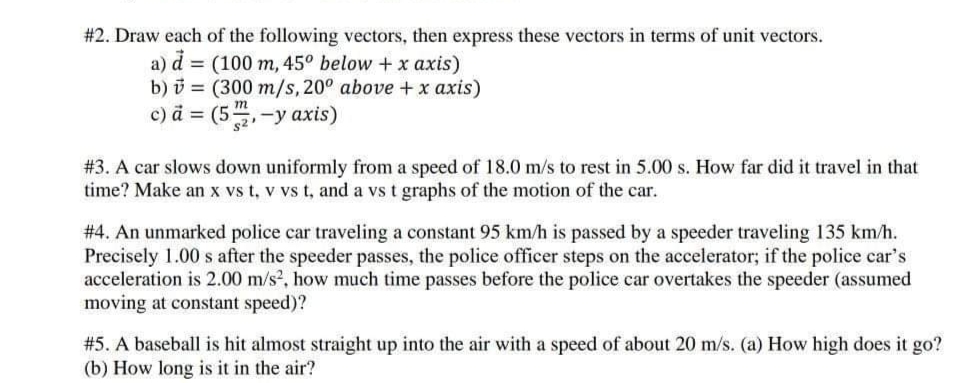# 4. An unmarked police car traveling a constant 95 km/h is passed by a speeder traveling 135 km/h. Precisely 1.00 s after the speeder passes, the police officer steps on the accelerator; if the police car's acceleration is 2.00 m/s?, how much time passes before the police car overtakes the speeder (assumed moving at constant speed)?
# 4. An unmarked police car traveling a constant 95 km/h is passed by a speeder traveling 135 km/h. Precisely 1.00 s after the speeder passes, the police officer steps on the accelerator; if the police car's acceleration is 2.00 m/s?, how much time passes before the police car overtakes the speeder (assumed moving at constant speed)?
Physics for Scientists and Engineers with Modern Physics
10th Edition
ISBN:9781337553292
Author:Raymond A. Serway, John W. Jewett
Publisher:Raymond A. Serway, John W. Jewett
Chapter3: Vectors
Section: Chapter Questions
Problem 33P
Related questions
Question
Please help me answer number 4 with complete solution

Transcribed Image Text:#2. Draw each of the following vectors, then express these vectors in terms of unit vectors.
a) d = (100 m, 45° below +x axis)
b) i = (300 m/s, 20° above +x axis)
c) a = (5,-y axis)
m
s2
# 3. A car slows down uniformly from a speed of 18.0 m/s to rest in 5.00 s. How far did it travel in that
time? Make an x vs t, v vs t, and a vs t graphs of the motion of the car.
# 4. An unmarked police car traveling a constant 95 km/h is passed by a speeder traveling 135 km/h.
Precisely 1.00 s after the speeder passes, the police officer steps on the accelerator; if the police car's
acceleration is 2.00 m/s, how much time passes before the police car overtakes the speeder (assumed
moving at constant speed)?
#5. A baseball is hit almost straight up into the air with a speed of about 20 m/s. (a) How high does it go?
(b) How long is it in the air?
Expert Solution
This question has been solved!
Explore an expertly crafted, step-by-step solution for a thorough understanding of key concepts.
This is a popular solution!
Trending now
This is a popular solution!
Step by step
Solved in 2 steps with 2 images

Recommended textbooks for you

Physics for Scientists and Engineers with Modern …
Physics
ISBN:
9781337553292
Author:
Raymond A. Serway, John W. Jewett
Publisher:
Cengage Learning

Physics for Scientists and Engineers
Physics
ISBN:
9781337553278
Author:
Raymond A. Serway, John W. Jewett
Publisher:
Cengage Learning

College Physics
Physics
ISBN:
9781285737027
Author:
Raymond A. Serway, Chris Vuille
Publisher:
Cengage Learning

Physics for Scientists and Engineers with Modern …
Physics
ISBN:
9781337553292
Author:
Raymond A. Serway, John W. Jewett
Publisher:
Cengage Learning

Physics for Scientists and Engineers
Physics
ISBN:
9781337553278
Author:
Raymond A. Serway, John W. Jewett
Publisher:
Cengage Learning

College Physics
Physics
ISBN:
9781285737027
Author:
Raymond A. Serway, Chris Vuille
Publisher:
Cengage Learning

College Physics
Physics
ISBN:
9781305952300
Author:
Raymond A. Serway, Chris Vuille
Publisher:
Cengage Learning

College Physics
Physics
ISBN:
9781938168000
Author:
Paul Peter Urone, Roger Hinrichs
Publisher:
OpenStax College

Principles of Physics: A Calculus-Based Text
Physics
ISBN:
9781133104261
Author:
Raymond A. Serway, John W. Jewett
Publisher:
Cengage Learning